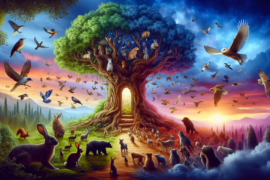You’re about to embark on a thrilling journey into the world of crafting compelling animal stories. Whether you’re a beginner, an aspiring writer, or simply someone who loves animals, this article will guide you on the best ways to captivate your audience and bring your animal characters to life. From creating memorable characters to building engaging plots, get ready to unlock the secrets to captivating storytelling that will have your readers eagerly flipping through the pages of your animal adventures. So grab your pen and let’s dive into the exciting world of crafting compelling animal stories!
Choosing the Right Animal
When it comes to crafting compelling animal stories, the first step is choosing the right animal to focus on. Consider your target audience and their interests. Are you writing for young children or adults? Depending on the age group, you may want to select an animal that is relatable and captures their imagination.
It’s also important to choose an animal with unique characteristics. Whether it’s a majestic lion or a playful dolphin, the animal should have qualities that make it stand out and capture the reader’s attention. This uniqueness will help make your story more compelling and memorable.
Before diving into writing, take the time to research the animal’s behavior and traits. Learn about their natural habitat, diet, and social interactions. This knowledge will allow you to incorporate accurate information and make your story more realistic. Understanding the animal’s behavior will help you create characters and situations that resonate with readers.
Creating Engaging Characters
Once you’ve selected the perfect animal, it’s time to create engaging characters. While animals may not have human traits, you can give them relatable characteristics that will make readers connect with them on a deeper level. Perhaps your animal protagonist is brave, curious, or mischievous. These traits will help readers form an emotional bond with the character.
In addition to the protagonist, it’s essential to develop supporting characters that add depth to the story. Consider including a variety of animal companions that bring different perspectives and skills to the table. This diversity in characters will make the story more dynamic and interesting.
Above all, the protagonist should have a clear goal. What does the animal want to achieve or overcome? This goal will give the story direction and purpose, keeping readers engaged and rooting for the protagonist throughout the narrative.

Developing a Captivating Plot
A captivating plot is crucial to keep readers hooked and entertained. Start by establishing a conflict or problem that the protagonist must face. This conflict could be an internal struggle or an external challenge. Whether it’s a fight for survival or an emotional journey of self-discovery, the conflict should create tension and drive the story forward.
Outline a clear beginning, middle, and end to give your story structure. The beginning should introduce the protagonist, their world, and the conflict. The middle should develop the plot and throw obstacles in the protagonist’s path. Finally, the end should bring resolution and closure to the story.
To keep readers engaged, incorporate suspense and tension throughout the narrative. You can do this by adding unexpected twists and turns, time pressure, or moments of danger. Build anticipation and keep readers guessing what will happen next. This element of suspense will make your story hard to put down.
Setting the Scene
Setting the scene is essential in animal stories to transport readers into the animal’s habitat. Describe the animal’s environment in vivid detail, using sensory details and imagery. Paint a picture with your words, allowing readers to see, hear, smell, and feel the surroundings. This level of description will enhance the readers’ experience and make the story more immersive.
Don’t just focus on the physical aspects of the habitat, but also depict the role of the environment in the story. Show how it influences the protagonist’s behavior and actions. Is the harsh climate a barrier the animal must overcome? Does the lush forest provide opportunities for adventure? The environment should play a significant role in shaping the narrative.

Using Dialogue Effectively
Although animals may not speak human languages, you can still give them a voice and personality through dialogue. Use dialogue to convey emotions, motivations, and thoughts. By giving animals a voice, readers can better understand their perspective and form a deeper connection with the characters.
When writing dialogue, ensure it is realistic and natural. Consider how animals communicate—through vocalizations, body language, or even telepathy in fantastical stories. Use these cues to create dialogue that feels authentic. Don’t be afraid to experiment with different styles of communication to fit your animal characters.
Including Educational Information
While crafting an engaging story, it’s important to incorporate educational information about the animal. Share accurate facts about the animal’s diet, habitat, behavior, and conservation status. This information will not only make your story more informative but also raise awareness and promote understanding.
In addition to factual information, highlight conservation messages throughout the story. Teach readers about the importance of protecting the animal’s habitat and the role they play in the ecosystem. By educating readers, you can inspire them to take action and make a positive impact on the world around them.
Above all, encourage understanding and empathy towards animals. Show readers that animals have their own unique experiences, emotions, and struggles. By illustrating these aspects, you can foster a sense of connection between humans and animals, promoting empathy and compassion.
Using Emotion and Empathy
To create a compelling animal story, it’s essential to evoke readers’ emotions. Share touching and exciting experiences that animals go through. Whether it’s a heartwarming reunion, a thrilling chase, or a heartbreaking loss, these emotional moments will resonate with readers.
Highlight the relatable emotions and struggles of animals. Just like humans, animals experience fear, joy, sadness, and love. By illustrating these emotions through your characters, readers will feel a deeper connection and empathy towards them.
Additionally, emphasize the bond between animals and humans. Show how animals can bring joy, companionship, and even healing to humans. This connection can be a powerful theme throughout your story, engaging readers and reinforcing the importance of respecting and protecting animals.
Adding Humor and Quirkiness
Don’t be afraid to infuse light-hearted humor into your animal story. Animal behavior can be funny and quirky, and incorporating these elements will make your story more entertaining. Create funny situations and unexpected scenarios that will leave readers smiling.
Whether it’s a clumsy penguin belly-flopping into the water or a mischievous monkey stealing bananas, these humorous moments will add a touch of joy to your story. Remember that laughter can be a powerful tool to engage readers and make your story memorable.
Crafting Memorable Endings
As you approach the end of your story, it’s important to build towards a satisfying resolution. Make sure the conflict or problem introduced earlier is addressed and resolved in a meaningful way. This resolution should feel earned and provide closure to the story.
Additionally, leave readers with a thought-provoking message. What lesson or insight do you want readers to take away from your story? By offering a message or moral, you can leave a lasting impact on your readers long after they’ve finished reading.
Finally, create a sense of closure and fulfillment. Tie up loose ends, provide a glimpse into the future, or leave readers with a sense of hope. This conclusion should leave readers feeling satisfied and content with the journey they’ve been on.
Editing and Revising
Once you’ve written your first draft, take the time to edit and revise your story. Read it through for clarity and coherence. Ensure that the plot flows smoothly and that the characters are consistent. Make any necessary changes to improve the overall structure and pacing of the story.
Check for grammar and spelling errors. A polished and error-free story will make a better impression on readers. Proofread thoroughly or consider asking someone else to review your work for any mistakes you may have missed.
Seek feedback from others, such as friends, family, or fellow writers. They can offer valuable insights and suggestions for improvement. Be open to feedback and use it to refine your story, making it as compelling as possible.
Crafting compelling animal stories for beginners requires attention to detail, creativity, and a deep understanding of the animal world. By following these tips and techniques, you can create stories that capture readers’ imaginations, inspire empathy, and promote a love for animals and nature. So grab your pen and embark on an exciting adventure, taking readers on a journey through the captivating world of animals. Happy writing!
